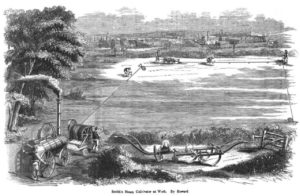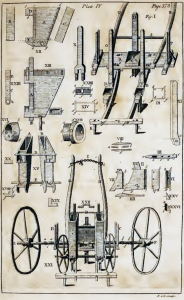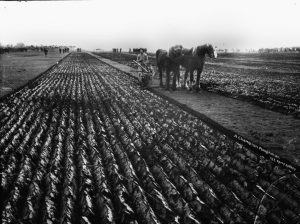The British Agricultural revolution is considered one of the causes of the First Industrial Revolution.

image source:https://en.wikipedia.org/wiki/John_Donaldson_(agriculturalist)#/media/File:British_agriculture,_1860,_p._220.jpg
The agricultural revolution consisted in a gradual transformation of the traditional agricultural system that began in Britain in the 18th century: this process included the reallocation of land ownership to make farms more compact and an increased investment in technical improvements, such as new machinery, better drainage, scientific methods of breeding and experimentation with crop rotation. Improved agricultural productivity freed up workers to work in other sectors of the economy, making the provision of food possible for a larger nonagricultural population.
New technologies that affected farming included:
The seed drill
The English lawyer Jethro Tull invented an improved seed drill in 1701. It was a mechanical seeder which distributed seeds evenly across a plot of land and planted them at the correct depth. This was important because the

image source: https://en.wikipedia.org/wiki/Jethro_Tull_(agriculturist)#/media/File:Jethro_Tull_seed_drill_(1762).png
yield of seeds harvested to seeds planted at that time was around four or five. Tull’s seed drill was very expensive and not very reliable and therefore did not have much of an effect. Good quality seed drills were not produced until the mid 18th century.
The Dutch Plough
Joseph Foljambe’s Rotherham plough of 1730 was the first commercially successful iron plough. The threshing machine, invented by the Scottish engineer Andrew Meikle in 1784, displaced hand threshing with a flail, a
laborious job that took about one-quarter of agricultural labour. It took several decades to diffusevand was the final straw for many farm labourers, who faced near starvation, leading to the 1830 agricultural rebellion of the Swing Riots.

image source: https://en.wikipedia.org/wiki/Plough#/media/File:A_champion_ploughman_from_The_Powerhouse_Museum_Collection.jpg
info source: https://en.wikipedia.org/wiki/British_Agricultural_Revolution
